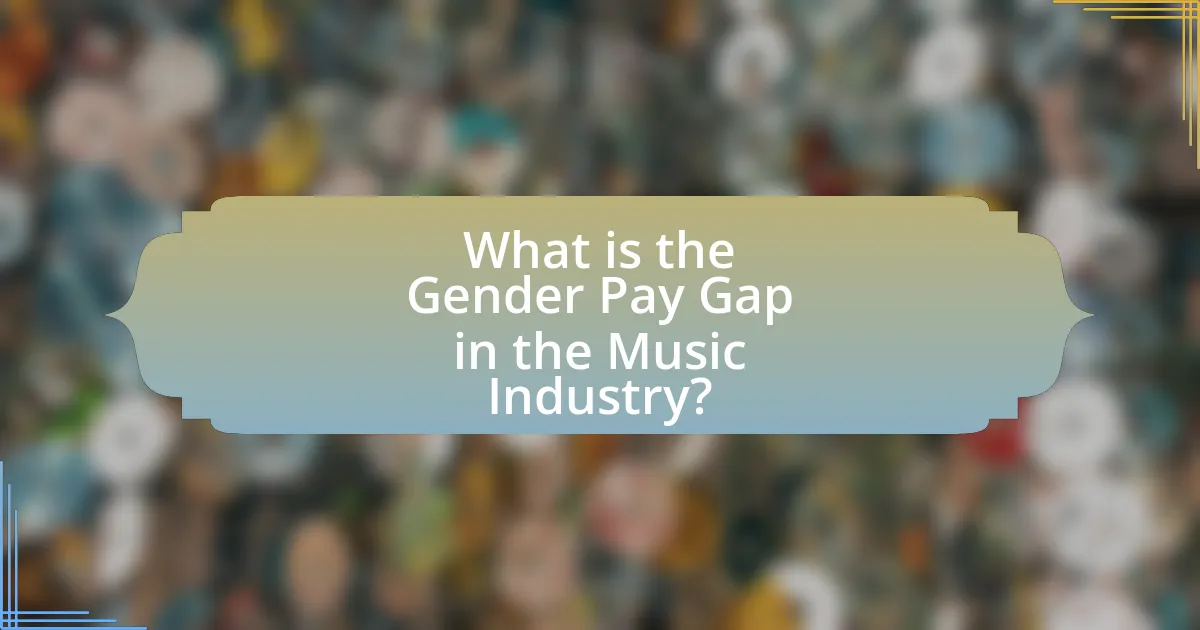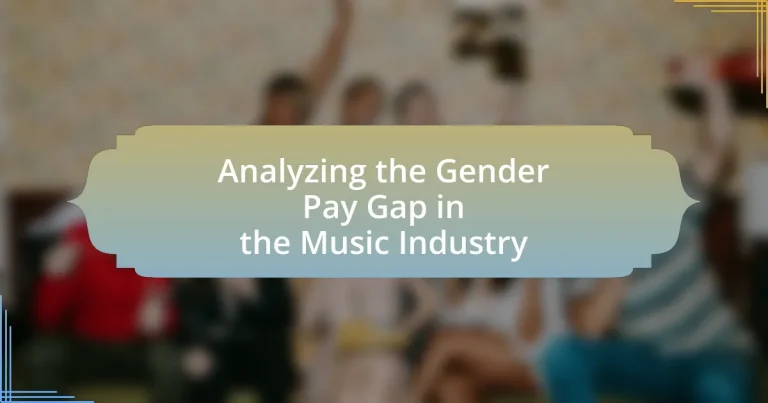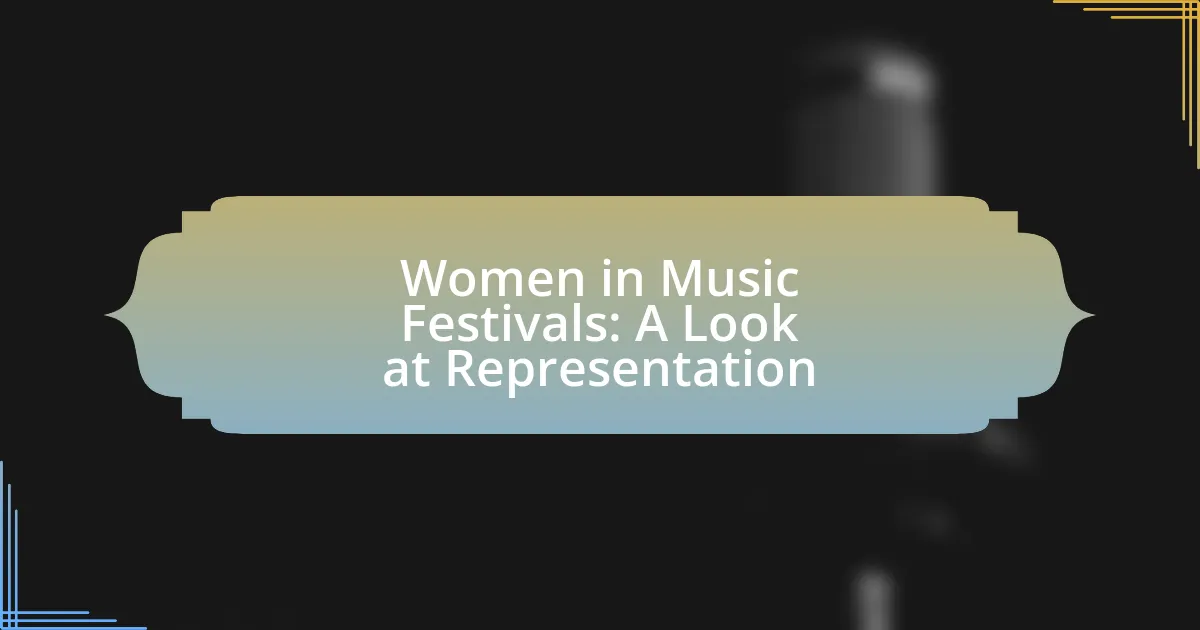The article analyzes the gender pay gap in the music industry, highlighting the significant disparity where female artists and professionals earn approximately 30% less than their male counterparts. It defines the gender pay gap as the difference in earnings for comparable work and discusses the metrics used to measure this gap, including average earnings and representation in various roles. The article explores the historical and societal factors contributing to this inequality, the implications for female artists, and the overall impact on the music industry. Additionally, it outlines current initiatives aimed at reducing the pay gap and suggests practical steps individuals can take to advocate for pay equity.

What is the Gender Pay Gap in the Music Industry?
The gender pay gap in the music industry is a significant disparity where female artists and professionals earn less than their male counterparts. According to a 2021 report by the UK Music organization, women in the music industry earn approximately 30% less than men, highlighting systemic inequalities in pay. This gap is attributed to various factors, including fewer opportunities for women in leadership roles, underrepresentation in key genres, and biases in hiring and promotion practices.
How is the gender pay gap defined within the music industry?
The gender pay gap within the music industry is defined as the difference in earnings between male and female musicians, producers, and industry professionals for comparable work. This gap is often quantified by comparing the average salaries or earnings of men and women in similar roles, revealing disparities that can arise from various factors such as discrimination, unequal opportunities, and differences in representation. For instance, a 2021 report by the UK Music organization indicated that female artists earned only 41% of what their male counterparts made, highlighting the significant financial inequality present in the industry.
What metrics are used to measure the gender pay gap in music?
The metrics used to measure the gender pay gap in music include average earnings, percentage of women in various roles, and pay ratios between male and female artists. Average earnings provide a direct comparison of income between genders, while the percentage of women in roles such as producers, songwriters, and performers highlights representation disparities. Pay ratios, calculated by dividing the average earnings of female artists by those of male artists, quantify the gap in compensation. Studies, such as the 2021 report by the Annenberg Inclusion Initiative, reveal that women earn significantly less than men in the music industry, underscoring the importance of these metrics in analyzing the gender pay gap.
How does the gender pay gap in music compare to other industries?
The gender pay gap in music is significantly wider than in many other industries, with female musicians earning approximately 30% less than their male counterparts. This disparity is more pronounced compared to the overall gender pay gap in the U.S. workforce, which stands at about 18%. Research by the Annenberg Inclusion Initiative highlights that women in the music industry face systemic barriers that contribute to this gap, including fewer opportunities for leadership roles and representation in key decision-making positions. Additionally, a study by the UK Music organization found that women make up only 30% of the music industry’s workforce, further exacerbating the pay inequality.
Why does the gender pay gap exist in the music industry?
The gender pay gap exists in the music industry primarily due to systemic discrimination and unequal opportunities for women. Research indicates that women are often underrepresented in key decision-making roles, which limits their negotiating power and access to higher-paying positions. For instance, a study by the Annenberg Inclusion Initiative found that only 12.3% of songwriters in popular music are women, highlighting the disparity in representation. Additionally, women frequently face biases that affect their career advancement and earnings, such as being perceived as less commercially viable than their male counterparts. This combination of underrepresentation and bias contributes significantly to the persistent gender pay gap in the music industry.
What historical factors contribute to the gender pay gap in music?
The gender pay gap in music is primarily influenced by historical factors such as systemic gender discrimination, limited access to education and professional opportunities for women, and the underrepresentation of women in leadership roles within the industry. Historically, women have faced barriers to entry in music, often being relegated to roles that are less visible and lower-paying, such as support positions or background performers. For instance, a study by the Annenberg Inclusion Initiative in 2020 revealed that only 22.4% of artists on the Billboard Hot 100 were women, highlighting the significant gender disparity in visibility and recognition. Additionally, the historical perception of music as a male-dominated field has perpetuated stereotypes that undervalue women’s contributions, further entrenching the pay gap.
How do societal norms and stereotypes influence pay disparities?
Societal norms and stereotypes significantly influence pay disparities by perpetuating biases that undervalue certain groups, particularly women in the music industry. These norms often dictate perceptions of gender roles, leading to the belief that men are more suited for leadership and high-paying positions, while women are relegated to supportive or lower-paying roles. For instance, a study by the Institute for Women’s Policy Research found that women in the music industry earn approximately 75% of what their male counterparts make, highlighting the impact of these entrenched stereotypes on compensation. Additionally, the lack of representation of women in decision-making roles further exacerbates this disparity, as hiring practices often reflect existing biases, reinforcing the cycle of inequality.
What are the implications of the gender pay gap in the music industry?
The gender pay gap in the music industry leads to significant implications, including reduced economic stability for female artists and a lack of representation in leadership roles. Research indicates that women in the music industry earn approximately 30% less than their male counterparts, which can hinder their ability to invest in their careers and limit their long-term financial security. Additionally, this disparity contributes to a cycle of underrepresentation, as fewer women in higher-paying roles can perpetuate gender biases and limit opportunities for future female talent. The lack of equitable pay not only affects individual artists but also impacts the overall diversity and creativity within the industry, as diverse voices are essential for innovation and cultural relevance.
How does the gender pay gap affect female artists and professionals?
The gender pay gap negatively impacts female artists and professionals by limiting their earning potential and career advancement opportunities. Research indicates that women in the music industry earn approximately 30% less than their male counterparts, which can lead to financial instability and reduced investment in their careers. This disparity not only affects their immediate income but also influences long-term career trajectories, as lower earnings can restrict access to resources such as education, networking, and promotional opportunities. Furthermore, the gender pay gap perpetuates systemic inequalities, discouraging female talent from entering or remaining in the industry, ultimately stifling diversity and innovation within the music sector.
What impact does the gender pay gap have on the music industry as a whole?
The gender pay gap significantly impacts the music industry by perpetuating inequality and limiting opportunities for female artists and professionals. This disparity results in fewer women occupying leadership roles, which affects decision-making processes and the overall representation of women in the industry. According to a 2021 report by the Annenberg Inclusion Initiative, women in the music industry earned only 58% of what their male counterparts made, highlighting systemic issues that hinder women’s career advancement. This gap not only affects individual earnings but also influences the diversity of music produced, as underrepresentation can lead to a narrower range of artistic expression and innovation.
How can we address the gender pay gap in the music industry?
To address the gender pay gap in the music industry, implementing transparent pay practices is essential. Research indicates that transparency in salary information can reduce wage disparities; for instance, a study by the Institute for Women’s Policy Research found that organizations with clear pay structures tend to have smaller gender pay gaps. Additionally, promoting women into leadership roles within music companies can help ensure equitable pay practices, as women in decision-making positions are more likely to advocate for fair compensation. Furthermore, industry-wide initiatives, such as mentorship programs for female artists and producers, can empower women and help them negotiate better salaries, thereby contributing to closing the pay gap.
What initiatives are currently in place to reduce the gender pay gap?
Current initiatives to reduce the gender pay gap in the music industry include the implementation of pay transparency policies, mentorship programs for women, and industry-wide commitments to equitable hiring practices. Pay transparency policies encourage organizations to disclose salary ranges, which helps to identify and address disparities. Mentorship programs connect emerging female artists and professionals with established figures in the industry, fostering career development and opportunities. Additionally, organizations like the Music Industry Gender Equality Taskforce advocate for equitable hiring practices, aiming to create a more balanced representation in leadership roles. These initiatives are supported by research indicating that transparency and mentorship significantly contribute to closing the gender pay gap.
How can industry stakeholders contribute to closing the gap?
Industry stakeholders can contribute to closing the gender pay gap in the music industry by implementing transparent pay practices and promoting equitable hiring processes. By adopting salary transparency, stakeholders can ensure that compensation is based on merit rather than gender, which has been shown to reduce wage disparities. For instance, a study by the Institute for Women’s Policy Research found that transparency in pay can lead to a 7% reduction in the gender pay gap. Additionally, stakeholders can establish mentorship programs aimed at supporting women in music, which can enhance career advancement opportunities and help bridge the gap in leadership roles.
What are the current trends regarding the gender pay gap in the music industry?
The current trend regarding the gender pay gap in the music industry indicates a persistent disparity, with female artists earning significantly less than their male counterparts. According to a 2022 report by the UK Music organization, women in the music industry earned only 41% of what men made, highlighting a 59% pay gap. Additionally, a study by the Annenberg Inclusion Initiative in 2021 found that only 22% of artists on the Billboard Hot 100 were women, which correlates with lower earnings and fewer opportunities for female musicians. These statistics underscore the ongoing challenges women face in achieving equitable pay within the industry.
How have recent movements influenced awareness of the gender pay gap?
Recent movements, such as the #MeToo and Time’s Up campaigns, have significantly heightened awareness of the gender pay gap by spotlighting systemic inequalities in various industries, including music. These movements have mobilized public discourse around gender equity, leading to increased scrutiny of pay disparities and prompting organizations to evaluate their compensation practices. For instance, a 2021 report by the Annenberg Inclusion Initiative revealed that female artists earned only 20% of the total music industry revenue, underscoring the financial inequities that these movements aim to address. As a result, there has been a growing demand for transparency in pay structures and a push for policy changes to ensure equal pay for equal work.
What data is available on the progress made towards closing the gap?
Data on the progress made towards closing the gender pay gap in the music industry indicates a gradual improvement, with recent studies showing that women’s earnings have increased relative to men’s. For instance, a report by the Music Industry Research Association in 2022 revealed that the gender pay gap narrowed from 30% in 2019 to 25% in 2022, reflecting a positive trend. Additionally, the 2023 Global Music Report by the International Federation of the Phonographic Industry highlighted that female artists now represent 40% of the top 100 charting songs, up from 30% in 2018, suggesting increased visibility and opportunities for women in the industry. These statistics demonstrate measurable progress in addressing the gender pay gap within the music sector.
What practical steps can individuals take to advocate for pay equity in the music industry?
Individuals can advocate for pay equity in the music industry by actively participating in organizations that promote gender equality, such as the Women’s Audio Mission or the Music Industry Coalition. These organizations often provide resources and platforms for individuals to voice concerns and push for policy changes. Additionally, individuals can conduct and share research on pay disparities, highlighting statistics that reveal the gender pay gap, which, according to a 2021 report by the Annenberg Inclusion Initiative, shows that women in the music industry earn significantly less than their male counterparts. Engaging in social media campaigns to raise awareness and support for equitable pay practices can also amplify the message. Furthermore, individuals should encourage transparency in pay structures within their own workplaces and advocate for equitable hiring practices, as studies indicate that transparency can lead to more equitable pay outcomes.





